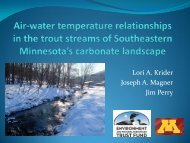Minnesota Water Resources Conference - Water Resources Center ...
Minnesota Water Resources Conference - Water Resources Center ...
Minnesota Water Resources Conference - Water Resources Center ...
You also want an ePaper? Increase the reach of your titles
YUMPU automatically turns print PDFs into web optimized ePapers that Google loves.
Poster Session 4:45–5:45<br />
BOOK OF ABSTRACTS<br />
Tuesday, Monday, October 27 23<br />
City Sustainability—<strong>Water</strong> as Part of the Big Picture<br />
Lisa Tilman, Emmons & Olivier <strong>Resources</strong>, Inc., ltilman@eorinc.com; and Brett Emmons, Emmons & Olivier <strong>Resources</strong>, Inc.<br />
A City Sustainability Plan, one of the first in the state, is being prepared to guide the City of Burnsville in<br />
implementation of fourteen Sustainability Best Practice Areas identified by the City. The Sustainability Plan<br />
translates the city’s best practice goals into measurable implementation actions through a plan development<br />
process that combined the expertise of a diverse project team with the ideas of a broad group of city staff.<br />
This poster includes the activities developed for consideration by Burnsville to guide sustainable surface and<br />
groundwater management and highlights the strong inter-relationship between water management and other<br />
sustainability areas.<br />
Taming the Lower Sheyenne River<br />
Jeffry Volk, Moore Engineering, Inc., jvolk@mooreengineeringinc.com; John Wirries, Moore Engineering, Inc.<br />
Flooding in the Red River Valley has been a challenge for <strong>Minnesota</strong> and North Dakota communities. The<br />
Sheyenne River winds through deep ravines in Eastern North Dakota before spilling into the flat lake bottom<br />
of ancient Lake Agassiz, where intermixing river systems give rise to overland flooding. In Cass County, North<br />
Dakota, the local water resource districts have, for decades, searched for solutions to this flooding. These<br />
solutions included levees, diversions, and upstream retention on both the Sheyenne and Maple Rivers. In 2006,<br />
the last piece of a four part solution was implemented, retention on the Maple River.<br />
Maple River Dam is located 40 miles southwest of Fargo, ND. The Maple River is a major tributary of the<br />
Sheyenne River, making up nearly 40% of the watershed. Maple River Dam has available over 60,000 acre feet of<br />
storage. Yet as a “dry dam” it retains no water except during a flood event. The use of a dry dam allows for flood<br />
control while minimizing the environmental impacts of a dam. Together with other improvements, the Maple<br />
River Dam helps to reduce flood damage in the lower Sheyenne River <strong>Water</strong>shed.<br />
<strong>Minnesota</strong> <strong>Water</strong> <strong>Resources</strong> <strong>Conference</strong>, October 27–28, 20078 54
















